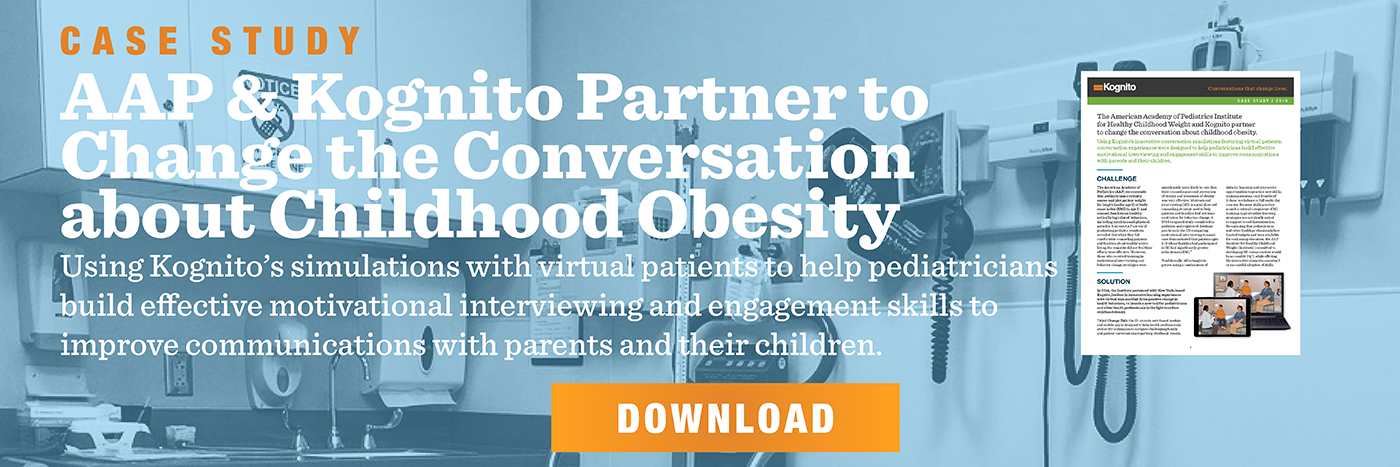Developing Interpersonal Communication and Professionalism Competencies
Why isn’t healthcare provider communication training standardized?
Dr. Calvin Chou writes in the New England Journal of Medicine:
Would you trust a surgeon who told you, “I haven’t had any formal training for this procedure, observed any experts, nor received feedback on my skills, BUT over the course of time, through trial and error, I think I’ve found what works for me”? That is essentially how physicians were “trained” in communication skills for decades.
Healthcare students and practicing professionals face significant challenges when trying to communicate with patients. Patient populations are incredibly diverse when it comes to knowledge level, health literacy, social determinants of health, beliefs, and other factors. There is no one-size-fits-all conversation that will apply to all patients; quality care depends on meeting the unique needs of patients, one at a time.
With research indicating that effective provider-patient communication delivers safer care, high-quality care, and more cost-effective care – all of which drive value in healthcare – it is critical to invest in these skills for health professionals.
How should healthcare institutions focus on provider-patient communication?
To enhance patient safety and care quality, there are a variety of evidence-based best practices that help healthcare institutions enhance communication skills.
One solution is investing in communication skills training for all staff. This could include techniques such as the use of open-ended questions, motivational interviewing, and more. Schools of health professions can also focus on incorporating provider-patient communication early into curricula.
Being ready to sit down with a patient equipped with effective communication skills probably won’t happen overnight or come naturally. Rather, it requires training and ongoing practice. Luckily, there are many advantages to building these skills for physicians, nurses, social workers, and future healthcare professionals to deliver high-quality care.
How can virtual human simulation technology train healthcare professionals in communication skills?
Kognito standardized patient simulation scenarios provide effective, evidence-based health professions training that is scalable, replicable, and trackable. These simulations are used to train health professions students and practicing providers, including physicians, NPs, nurses, PAs, NAs, social workers, and pharmacists.
In Kognito’s simulations, learners interact with an emotionally responsive virtual human to practice empathy, curiosity, and openness to patient experiences. The learner must engage each unique virtual patient persona while exploring the sociocultural factors critical to the patient’s health, and applying collaborative care and motivational interviewing techniques to achieve the objectives of the patient visit. Learners experience the impact of common pitfalls on critical healthcare discussions and formulate strategies for how best to navigate challenging patient conversations.
“Kognito simulations are very realistic…you learn something that you can apply every day in your practice”
-Adina Kalet, MD, MPH, Director, Research on Medical Education Outcomes, NYU School of Medicine
What does good communication in healthcare settings look like?
Kognito’s healthcare simulations incorporate tenants of motivational interviewing, including change talk, affirmations, elicit-provide-elicit, open-ended questions, and more. Motivational interviewing is a method with growing popularity in healthcare that can help health professionals recognize where a patient is in this cycle, tailor their communication accordingly, and build patient motivation for change.
For example, here are a sample of common mistakes that health professionals may be making in their conversations with patients.
1. Complimenting, not affirming
X Compliment: I think it’s really great that you’re planning to quit smoking.
✓ Affirmation: You thought very carefully about quitting smoking and decided you wanted to avoid health complications in the future.
2. Giving advice, not offering ideas
X Giving advice: If you don’t lose weight, you’ll be at high risk for diabetes.
✓ Offering ideas: Would it be okay if I shared some information about how weight affects diabetes risk? … What do you make of that?
3. Asking too many questions
There are several ways to avoid the question-answer trap. One of them is to replace multiple closed questions with a smaller number of open-ended questions.
X Closed questions: Did you lose any weight? Were you active for 30 minutes a day? Did you follow the nutrition guidelines?
✓ Open-ended question: Last time you said you wanted to eat better and be more active. How’s that going?
How can Kognito help?
All of these techniques take practice. If you’re interested in learning how to reframe your own conversations with patients or those in your practice, hospital, or healthcare institution, learn more about our role-play simulations in the healthcare space.
To request a demo or learn more about Kognito’s growing portfolio of patient simulation scenarios, contact us at info@kognito.com.
Visit Us at IMSH
Learning Lab: Better Communications, Better Providers, Empowered Patients: Conversations Simulations with Responsive Virtual Humans
Learn how Kognito is leveraging its responsive virtual human technology to improve HCP communication skills and activate patients through simulated conversations about chronic disease, substance use, opioids, mental health, and adherence. The presentation will include demonstrations of Kognito’s evidence-based simulations and implementation examples from several healthcare organizations.
Date and Time: Tuesday, January 21st, 10:00-11:30, Room 5B
And visit us at Booth 206 to learn more!
